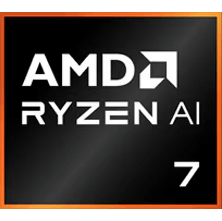AMD Ryzen AI 7 Pro 360 vs Intel Core 7 240H
We compared two laptop CPUs: AMD Ryzen AI 7 Pro 360 with 8 cores 2.0GHz and Intel Core 7 240H with 10 cores 2.5GHz . You will find out which processor performs better in benchmark tests, key specifications, power consumption and more.
Main Differences
AMD Ryzen AI 7 Pro 360 's Advantages
Better graphics card performance
Higher specification of memory (8000 vs 6400)
Larger memory bandwidth (89.6GB/s vs 83.2GB/s)
More modern manufacturing process (4nm vs 10nm)
Intel Core 7 240H 's Advantages
Newer PCIe version (5.0 vs 4.0)
Higher base frequency (2.5GHz vs 2.0GHz)
Larger L3 cache size (24MB vs 16MB)
Lower TDP (45W vs 54W)
Score
Benchmark
Cinebench R23 Single Core
AMD Ryzen AI 7 Pro 360
+3%
1957
Intel Core 7 240H
1891
Cinebench R23 Multi Core
AMD Ryzen AI 7 Pro 360
13793
Intel Core 7 240H
+20%
16631
Geekbench 6 Single Core
AMD Ryzen AI 7 Pro 360
2669
Intel Core 7 240H
2688
Geekbench 6 Multi Core
AMD Ryzen AI 7 Pro 360
11926
Intel Core 7 240H
+11%
13279
Cinebench 2024 Single Core
AMD Ryzen AI 7 Pro 360
108
Intel Core 7 240H
+3%
112
Cinebench 2024 Multi Core
AMD Ryzen AI 7 Pro 360
708
Intel Core 7 240H
+20%
851
Passmark CPU Single Core
AMD Ryzen AI 7 Pro 360
+1%
3933
Intel Core 7 240H
3858
Passmark CPU Multi Core
AMD Ryzen AI 7 Pro 360
21490
Intel Core 7 240H
+5%
22770
General Parameters
Oct 2024
Release Date
Dec 2024
Amd
Manufacturer
Intel
Laptop
Type
Laptop
x86-64
Instruction Set
x86-64
Zen 5 (Strix Point)
Core Architecture
Raptor Lake
-
Processor Number
240H
FP8
Socket
BGA-1744
Radeon 880M
Integrated Graphics
Iris Xe Graphics (64EU)
Ryzen AI 7 (Zen 5 (Krackan Point))
Generation
Core 7(Raptor Lake-H Refresh)
Package
Transistor Count
-
4 nm
Manufacturing Process
10 nm
15-54 W
Power Consumption
35-45 W
W
Max Turbo Power Consumption
115 W
100 °C
Peak Operating Temperature
100 °C
TSMC
Foundry
Intel
6 nm
I/O Process Size
-
CPU Performance
3
Performance Cores
6
6
Performance Core Threads
12
2.0 GHz
Performance Core Base Frequency
2.5 GHz
5 GHz
Performance Core Turbo Frequency
5.2 GHz
5
Efficiency Cores
4
10
Efficiency Core Threads
4
2.0 GHz
Efficiency Core Base Frequency
1.8 GHz
3.3 GHz
Efficiency Core Turbo Frequency
4 GHz
8
Total Core Count
10
16
Total Thread Count
16
100 MHz
Bus Frequency
100 MHz
20
Multiplier
25
80 K per core
L1 Cache
80 K per core
1 MB per core
L2 Cache
2 MB per core
16 MB shared
L3 Cache
24 MB shared
No
Unlocked Multiplier
No
1
SMP
1
Memory Parameters
DDR5-5600,LPDDR5X-8000
Memory Types
DDR5-5600,DDR4-3200,LPDDR5-6400,LPDDR5x-6400,LPDDR4x-4267
256 GB
Max Memory Size
96 GB
2
Max Memory Channels
2
89.6 GB/s
Max Memory Bandwidth
83.2 GB/s
Yes
ECC Memory Support
No
Graphics Card Parameters
true
Integrated Graphics
true
800 MHz
GPU Base Frequency
300 MHz
2900 MHz
GPU Max Dynamic Frequency
1550 MHz
768
Shader Units
512
48
Texture Units
32
32
Raster Operation Units
16
12
Execution Units
64
15
Power Consumption
15
4.45 TFLOPS
Graphics Performance
1.59 TFLOPS
AI Accelerator
AMD Ryzen™ AI
NPU
-
50 TOPS
Theoretical performance
-







